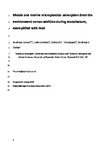Metals and marine microplastics: Adsorption from the environment versus addition during manufacture, exemplified with lead
| dc.contributor.author | Turner, A | |
| dc.contributor.author | Holmes, L | |
| dc.contributor.author | Thompson, RC | |
| dc.contributor.author | Fisher, AS | |
| dc.date.accessioned | 2020-02-28T11:16:56Z | |
| dc.date.issued | 2020-04-15 | |
| dc.identifier.issn | 0043-1354 | |
| dc.identifier.issn | 1879-2448 | |
| dc.identifier.other | 115577 | |
| dc.identifier.uri | http://hdl.handle.net/10026.1/15416 | |
| dc.description.abstract |
There are two means by which metals associate with microplastics in the aquatic environment. Firstly, they may be adsorbed to the plastic surface or hydrogenous-biogenic accumulations thereon, and secondly, they may be present in the polymeric matrix as functional additives or as reaction or recyclate residues. In this study, the relative significance of these associations is evaluated with respect to Pb in beached marine microplastics. Thus, adsorbed Pb was determined in <5 mm, neutrally-coloured polyethylene pellets that contained no detectable Pb added during manufacture by digestion in dilute aqua regia, while the bioaccessibility of this association was evaluated using an avian physiologically-based extraction test (PBET). Here, up to about 0.1 μg g-1 of Pb was adsorbed to the plastic and between about 60 and 70% of the metal was accessible. Lead present as additive or residue was determined by x-ray fluorescence analysis of a wider range of beached plastics (polyolefins and polyvinyl chloride), with a selection of positive samples grated to mm-dimensions and subjected to the PBET. Here, total Pb concentrations up to 40,000 μg g-1 and bioaccessibilities up to 16% were observed, with bioaccessible concentrations exceeding equivalent values for adsorbed Pb by several orders of magnitude. Ingestive exposure to Pb, and potentially other toxic metals, is more important through the presence of additives in historical plastics and recyclate residues in contemporary plastics than from adsorption, and it is recommended that future studies focus more on the environmental impacts and fate of metals bound in this form. | |
| dc.format.extent | 115577-115577 | |
| dc.format.medium | Print-Electronic | |
| dc.language | en | |
| dc.language.iso | en | |
| dc.publisher | Elsevier BV | |
| dc.rights | Attribution-NonCommercial 4.0 International | |
| dc.rights | Attribution-NonCommercial 4.0 International | |
| dc.rights | Attribution-NonCommercial 4.0 International | |
| dc.rights | Attribution-NonCommercial 4.0 International | |
| dc.rights | Attribution-NonCommercial 4.0 International | |
| dc.rights | Attribution-NonCommercial 4.0 International | |
| dc.rights.uri | http://creativecommons.org/licenses/by-nc/4.0/ | |
| dc.rights.uri | http://creativecommons.org/licenses/by-nc/4.0/ | |
| dc.rights.uri | http://creativecommons.org/licenses/by-nc/4.0/ | |
| dc.rights.uri | http://creativecommons.org/licenses/by-nc/4.0/ | |
| dc.rights.uri | http://creativecommons.org/licenses/by-nc/4.0/ | |
| dc.rights.uri | http://creativecommons.org/licenses/by-nc/4.0/ | |
| dc.subject | Microplastics | |
| dc.subject | Metals | |
| dc.subject | Lead | |
| dc.subject | Additive | |
| dc.subject | Adsorption | |
| dc.subject | Bioaccessibility | |
| dc.title | Metals and marine microplastics: Adsorption from the environment versus addition during manufacture, exemplified with lead | |
| dc.type | journal-article | |
| dc.type | Article | |
| plymouth.author-url | https://www.ncbi.nlm.nih.gov/pubmed/32044597 | |
| plymouth.volume | 173 | |
| plymouth.publication-status | Published | |
| plymouth.journal | Water Research | |
| dc.identifier.doi | 10.1016/j.watres.2020.115577 | |
| plymouth.organisational-group | /Plymouth | |
| plymouth.organisational-group | /Plymouth/Faculty of Science and Engineering | |
| plymouth.organisational-group | /Plymouth/Faculty of Science and Engineering/School of Biological and Marine Sciences | |
| plymouth.organisational-group | /Plymouth/Faculty of Science and Engineering/School of Geography, Earth and Environmental Sciences | |
| plymouth.organisational-group | /Plymouth/REF 2021 Researchers by UoA | |
| plymouth.organisational-group | /Plymouth/REF 2021 Researchers by UoA/UoA07 Earth Systems and Environmental Sciences | |
| plymouth.organisational-group | /Plymouth/Research Groups | |
| plymouth.organisational-group | /Plymouth/Research Groups/BEACh | |
| plymouth.organisational-group | /Plymouth/Research Groups/Marine Institute | |
| plymouth.organisational-group | /Plymouth/Users by role | |
| plymouth.organisational-group | /Plymouth/Users by role/Academics | |
| plymouth.organisational-group | /Plymouth/Users by role/Researchers in ResearchFish submission | |
| dc.publisher.place | England | |
| dcterms.dateAccepted | 2020-01-31 | |
| dc.rights.embargodate | 2021-1-30 | |
| dc.identifier.eissn | 1879-2448 | |
| dc.rights.embargoperiod | Not known | |
| rioxxterms.versionofrecord | 10.1016/j.watres.2020.115577 | |
| rioxxterms.licenseref.uri | http://creativecommons.org/licenses/by-nc/4.0/ | |
| rioxxterms.licenseref.startdate | 2020-04-15 | |
| rioxxterms.type | Journal Article/Review |



